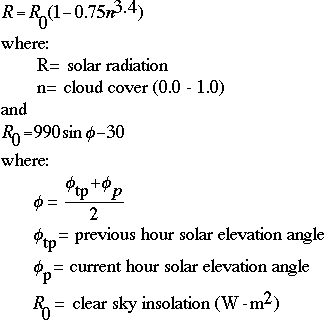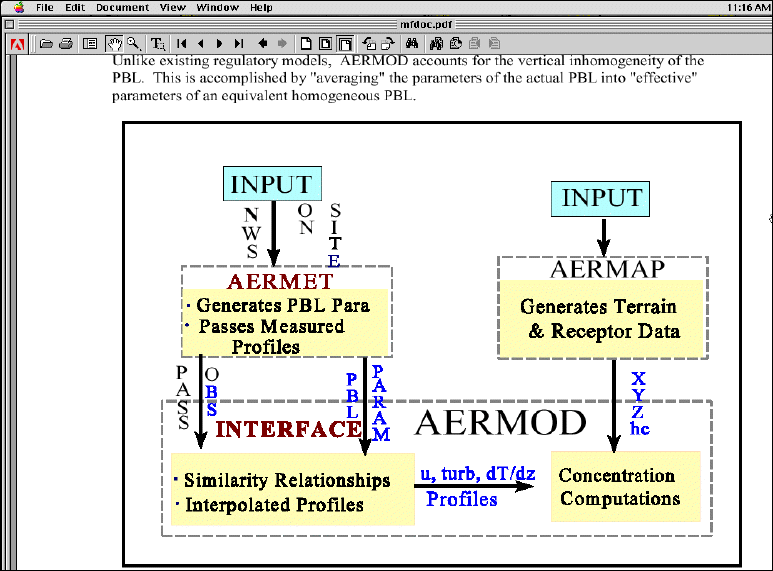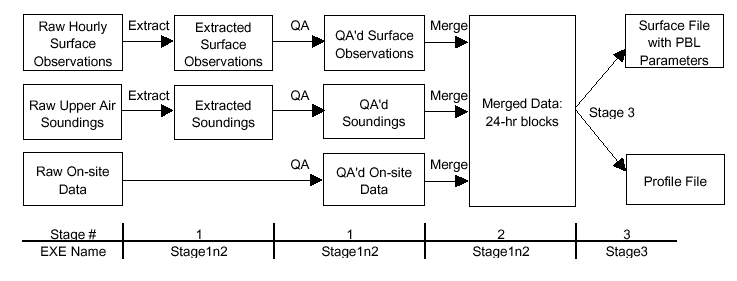| |
|
Data Pre-Processing
It is probably the rule rather than the exception that the data required for entry into a numerical simulation must be modified, or pre-processed, prior to entry into the computer. Some pre-processing is done "by hand" prior to entry into models, while some models have pre-processors built into the overall numerical code. For example, one of the key meteorological "observables" is the amount of solar radiation that is affecting the model region. In models such as AERMOD (a current air quality dispersion model), the amount of solar radiation (in units of Wm-2) must be corrected for the amount of cloud cover (as a percentage) prior to being entered into the model itself. AERMOD's meteorological preprocessor (AERMET) performs this calculation, but perhaps an example is helpful.
| The algorithm for solar radiation correction (Kasten, F. and G. Czeplak, 1980, "Solar and terrestrial radiation dependent on the amount and type of cloud." Solar Energy, 24:177-189.) is shown in the graphic at the right (click to see full-size). What value does the pre-processor solar properties calculator (courtesy of NOAA) give for this scenario? Suppose you are running the model for Denver, Colorado on January 3. Cloud cover was about 40% for that day. Assuming the model has this degree of temporal resolution, what's the amount of solar radiation for the period from 9 am to 10 am that should be entered into the model? Using a combination of the solar properties calculator and the solar radiation adjustment calculator, you should be able to calculate this amount. |

|
| It was mentioned at the beginning of this reading that many current atmospheric models have pre-processor code "bundled", or built into, the actual model code. AERMOD is again a good example of this. AERMOD has two pre-processors: AERMET, which handles all of the meteorological input data; AERMAP, which deals with terrain-related input data. The graphic at right is a screen-snap from the AERMOD description document (you can download the entire AERMOD model formulation description document in Adobe Acrobat PDF format if you want more details). The graphic shows the two pre-processors and their relationship to each other and to the overall AERMOD model.
Notice that in the AERMET model, observed data comes from two sources, the National Weather Service (NWS) and onsite meteorological data. This data is used to generate PBL parameters, which are then passed to the interface of the AERMOD model itself. |

|
Continuing on the use of AERMET as an example pre-processor, the graphic below shows the general flow structure:

Basically this diagram shows that there are three sources of input data -- raw hourly surface data, raw upper air soundings, and on-site data -- that must be processed, in this case into two "final" input files, a surface file with PBL information, and a meteorological profile file. Along the way, a variety of QA (quality assurance) procedures are implemented, and the data is merged into a single 24-hour block file.
Confused? Have a question? If so, check out the Frequently Asked Questions (FAQ) page or send mail to the OS411 tutor (os411tutor@shodor.org) with your question!
Report technical/content problems here
|
|
